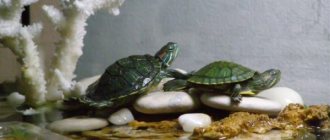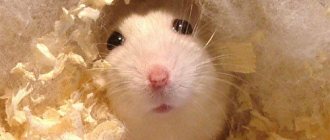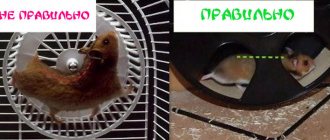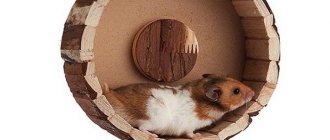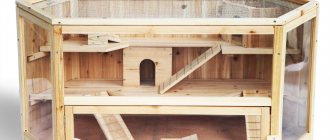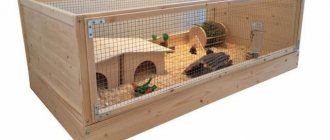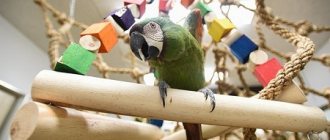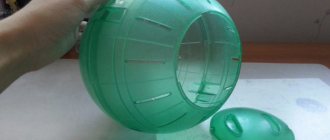If a couple of parrots of different sexes live in a cage, then the owner may think about the advisability of breeding them. To do this, a special nest for budgerigars is installed inside the cage, in which the female lays and incubates eggs.
It can be represented by a house, and it can be made with your own hands or purchased ready-made. It is recommended that you first study the basic requirements for this subject.
What is a nesting house for?
Many people get a second budgie so that their first pet doesn't get too bored. But if the birds are of different sexes, then they can begin mating games.
If they do not have a house or nest, the bird will not be able to begin the nesting process. Therefore, a nest is installed only if a person wants to independently breed birds.
It is quite simple to understand that birds have begun mating games, as this is accompanied by the following actions:
the male sings songs and dances around the female;- the birds show mutual signs of attention;
- they clean each other's feathers and feed from their beaks;
- Birds chirp and chirp constantly throughout the day;
- parrots regularly touch their beaks, which imitates a kiss.
If a person notices the beginning of such mating games, then he can install a nesting house inside the cage, designed for incubating chicks. The process must be completed in advance so that the female has time to organize the internal space to care for the small chicks.
The nest is installed on the bottom of the cage or suspended from the wall outside or inside.
It is best for the nest to be located inside the enclosure , as the bird will feel safe and calm. But this option is not suitable if the cell is small. Regardless of the method chosen, it is necessary to securely attach the product to the cage so that it does not fall or move.
Did your parrots have chicks?
Not really
How many days do lovebird parrots hatch eggs?
Often people buy lovebirds for their home. They gained such popularity thanks to simple living conditions, bright plumage, activity and curiosity. Over time, the birds mature and create pairs. And now they need human help to create good conditions for the birth of healthy chicks. Let's look at how to properly make a nest for lovebirds, what conditions they need and how long lovebirds sit on their eggs.
What shape and size do you need a house?
The exact dimensions depend on where exactly the nest will be installed. To do this, the dimensions, shape and location of the cell are taken into account. There are several types of nesting houses, which include:
- Horizontal. It is convenient because the bird can enter and exit without damaging the masonry. The disadvantages include the device of the taphole, represented by an entrance hole. It is too low, so the chicks often leave the nest too early.
- Vertical. It is considered not a very suitable option, since the entrance is located high, so the chicks have difficulty leaving the nest. The female herself can harm the eggs.
- Compromise. It is chosen most often, and you can do it yourself. It combines the advantages of the two above options. It has a suitable width, so it can easily accommodate the clutch and the female. The height of the entrance allows the chicks to leave the house in a timely manner. They will never be cramped inside the nest, so the likelihood of injury is minimized.
If a large nest is selected, then it is placed only on the bottom of the cage. Small houses can be attached to the walls. Combined nests have dimensions of 22x20 cm and a height of 20 cm.
Kinds
If a sweet pair of parrots lives happily and in abundance, then you can think about their offspring. The chance of a female laying eggs in a simple cage is extremely low. For this reason, she will need a nest.
The first option is a cardboard nesting house. It does not require any special materials or much effort. This nest is made from an ordinary cardboard box, in which it is enough to make a hole with a knife or scissors.
Then you need to place it correctly. The nest can be placed on the floor of the cage itself if there is enough space. However, experts in this matter believe that the female needs more free space, so a cardboard nest can be placed next to the cage or mounted on the roof if it is horizontal.
If the female moves freely around the apartment and is well oriented in space, then you can allocate another secluded place for the nest, for example, the one that the bird itself has chosen.
But a cardboard nest has plenty of disadvantages. Firstly, the material is not very comfortable for parrots, as it is difficult to move around. Secondly, the birds will constantly peck or chew cardboard, which can harm their digestive system. Thirdly, cardboard is not a very durable material, and a nest made from it is only suitable for one incubation period.
A more durable and high-quality material is plywood. A plywood nesting house is the second option. It can always be purchased at a pet store. However, finding a nest with dimensions suitable for large birds, such as Karelians, will not be easy.
For this reason, it is best to do it yourself, since it is financially inexpensive and will take no more than two hours. In addition, you can make a nest that fits exactly the size of the existing cage.
The best, but most labor-intensive option is a nest box , since for birds it represents conditions close to wild ones. It can be made from a natural log or stump. But finding a suitable piece of wood with a rotten interior will be very difficult. So you will have to spend time and effort removing the middle yourself.
How to make it yourself
Even people who do not have unique skills or experience can make a nesting house with their own hands.
To avoid mistakes, it is important to understand the design, which consists of the following parts:
- Letok. It is represented by the entrance to the nest and also has a round shape. Its diameter should exceed 4 cm. The tap hole is located on top of the front part of the nest. A perch can be installed below, making it easier for the female to enter the nest. A perch is not needed if the entrance is low.
- Litter. You can do it yourself or entrust this process to a female. Sawdust is considered an ideal basis for bedding. They perfectly absorb unpleasant odors and moisture. A layer about 3 cm thick is made. It is first recommended to mix sawdust with chamomile flowers, which have excellent antiseptic properties.
- Lid. It is advisable to make it folding or removable, which simplifies the process of cleaning the structure. Additionally, it becomes possible to periodically look inside to check the chicks.
- Ventilation. Chicks require fresh air, so special openings must be provided.
Before installing the nest inside the cage, disinfection is carried out. To do this, the structure is doused with boiling water or treated with special antiseptics. Afterwards, it is thoroughly washed to remove any remaining product.
Ready-made models
You can purchase or order a special nesting house in the store. Such models are already equipped with metal hooks, most of them have all the necessary parameters, are safe, equipped with hinged lids, perches, and convenient entry. There are models made from natural coconuts, wood, dried meadow grass stalks, plastic, metal rods, and fabric. The assortment is very large and varied, sometimes it is easier to buy a ready-made option than to make a nest with your own hands.
What you need to prepare for the design
If you plan to create a nest yourself, then you need to prepare the following elements:
- drawing of the future nest;
- wooden boards, and they can be obtained by destroying an ordinary wooden box;
- boards can be replaced with plywood, but it is not recommended to use chipboard, as this material is of low quality;
- screws and hammer;
- wooden perch;
- special fastenings with which the nest is fixed to the walls of the cage.
It is advisable to treat with antiseptics before connecting all the parts, which will greatly simplify the work.
The photo shows one of the drawing options for making a nest:
Nest for budgerigars: features of selection and manufacturing rules
join the discussion
Share with your friends
Budgerigars are brightly colored birds with a friendly disposition, which is why they are often chosen as pets. In order for parrots to feel comfortable and mate productively, they must be provided with a nesting house. This design can either be purchased ready-made or made independently from scrap materials.
Creating a house in stages
The manufacturing process of the structure is divided into stages:
- a diagram is formed on which the dimensions and parameters of the future nesting house are noted;
- drawings are made according to which wooden elements are cut;
- a floor, four walls and a roof are formed;
- the parts are connected using ordinary self-tapping screws or nails;
- the lid is fixed only on one side, so it turns out to be hinged;
- a taphole is cut out on the front wall, for which you need to step back about 5 cm from the edge, and a round hole is made, the diameter of which is from 4 to 6 cm;
- A wooden perch is inserted into the nest under the entrance.
At the end of the process, small holes are formed on the sides, which are intended for ventilation, and their diameter is approximately 0.8 cm.
How many steps does it take to hatch a Larvesta egg?
- Data Pokemon Data Pokédex
- moves
- Type table
- Capabilities
- PC.
- Evolution chains
- Pokemon locations
- Sprite gallery
- Links
- National Pokédex
- List of Pokemon with statistics
- Pokédex of Ultra Sun and Ultra Moon
- Let's go, Pikachu / Eevee Pokédex
- Pokédex Sword & Shield
- Breeding and egg groups
- Sword and shield
How to hang a nest box
It can be fixed outside or installed inside the cage. The first method is suitable if the cell is too small. But the female is more comfortable if the nesting area is located directly at the bottom of the cage. In this case, the male usually spends a lot of time on the roof of the house, which serves as a kind of support for the second parrot.
The cage must be spacious so that a person can lift the nest lid to carry out hygiene procedures or monitor the condition of the chicks. Fixation is done with wire or strands. It is important to ensure that the cage bars are highly durable and reliable. If the nest is suspended, you need to make sure that it cannot fall when there is masonry in it.
Breeding parrots should only be done in a quiet, warm and bright room, since if it is too noisy, the chicks will be afraid and therefore will not leave the nest on time.
Materials for work
The main requirement for materials for the construction of a shelter is their naturalness.
Common options are:
- Thin boards of deciduous trees (not treated with impregnations or other compounds).
- Plywood.
- Chipboard.
- Plastic.
The first option is the most acceptable, since the boards do not contain harmful chemical compounds. Softwood lumber is not suitable because it may contain resin pockets. Sulfur will subsequently be released from them, which will harm the chicks and the female.
Plywood is also suitable for construction, but birds may not like chipboard - it contains a high content of harmful substances.
Plastic houses sold in stores are not always liked by pets. They may have a strong odor or be awkward in size.
Tools you will need:
- jigsaw - for cutting material;
- screwdriver and self-tapping screws - for connecting parts;
- tape measure and pencil - for marking.
To determine the inlet hole (tap hole), a compass or container of the required diameter is suitable.
Nesting equipment
It is forbidden to place toys or a mirror in it, so only soft and warm bedding is created. The nest is intended for raising chicks, and not for active play. Therefore, all foreign objects must be kept outside of it. The house does not need special lighting, so it is enough to keep the room light.
The house is equipped with the following elements:
- a special perch that is fixed under the entrance and makes it easier for the female to form a clutch;
- bedding placed on the bottom of the house, and it is made from sawdust mixed with chamomile flowers, and all debris must first be removed.
The presence of a nest in a cage does not guarantee the breeding of parrots, since a trusting relationship must be established between the birds, and they must also be provided with optimal living conditions.
Looking for the ideal place for a nest
It is best to place the box with the cage where there will be no unnecessary fuss. This can be a room or any other room without bright light, lamps and crowds of people and animals. By the way, parrots can look after each other even in a cage with a large number of birds. But when the female is fertilized, she needs privacy. At this time, it is necessary to resettle her from the “neighbors”, ensuring peace and quiet.
From May to September, the cage and box can be kept in the fresh air. When it is cool, it is better to bring the nest indoors. If fertilization occurred during the cold season, then you just need to ventilate the room with the house from time to time.
Assembly
We begin assembling the nest box from the walls. First we fasten two walls together, then we attach a third to them, then a fourth. It turns out to be a box. The next stage is the bottom (it is already prepared and has a recess). Only the roof remains. It is better to make it removable for 3 reasons:
- it will be easier to care for the house in order to periodically clean it from the droppings of budgerigars and chicks;
- it will be possible to carefully observe what is happening inside without disturbing the female and offspring;
- for ventilation (instead of drilling additional holes in the house, it is better to open the roof sometimes).
Usage
Before hanging a homemade nesting house on the cage, it must be disinfected with steam or hot water. When the house is dry, you can pour a small amount of dry sawdust on the bottom. Birch trees are best, but in no case coniferous ones.
They also add dry chamomile, which is sold in pharmacies. One teaspoon will be enough. Its smell will protect the female, the clutch, and then the chicks from the invasion of parasites. There is no point in putting anything else in the house. Remember that a nesting house is not just a wooden box, but a secluded place for budgies and their offspring.
Make sure that it is not exposed to direct sunlight, especially in the hot season. No drafts, no heating devices, no open windows, no loud sounds - there should be nothing near the house that could interfere with the peace and comfort of the birds.
A prerequisite for breeding budgies is timely cleaning of the nesting house. While the female takes a closer look at the new place, arranges it, then, after some time, lays and incubates eggs, there is no need to clean the house.
The first cleaning should occur when the chicks are two weeks old. First, carefully move them into a pre-prepared cardboard box. Then remove everything unnecessary from the house: shells, droppings, leftover food. Be sure to replace old sawdust with new ones and wash the chicks' feet with warm water. Do everything as quickly as possible - the chicks should not be left without their mother for a long time. Repeat cleaning every other day or two.
If you liked our article, share it with your friends and like it.
If you have an opposite-sex pair of parrots living at home, and you are going to get offspring from them, sooner or later you will have to start building a house. Only in a nest for budgerigars can the mystery of the birth of chicks take place. How to understand that the time has come for reproduction, and which house to choose - you will find out by reading the article.
Preparing for nesting
A nest is necessary for budgerigars only in one case, when they begin nesting, that is, preparing for reproduction. Usually, a person buys a pair for his feathered friend and begins to look forward to the appearance of little chicks. But sometimes this process can be delayed or complicated. Let's look at some of the nuances that need to be taken into account when nesting budgies at home:
- Have patience and watch the birds first. If you notice that the wavy birds are constantly next to each other, cooing and plucking feathers, then soon they will need a nesting house. But it happens that a couple sits quietly and the birds are not at all interested in each other. It's best to look for another partner. To avoid making a mistake again, pay attention to the colors of the parrots. It is generally accepted that birds with the same shade of color form a pair well and quickly.
- Also consider the age of the birds. They are not ready to breed if they are less than a year old. The female may simply die while laying eggs. With good care and proper nutrition, parrots can produce offspring for up to about 9 years.
- Do not prepare a related couple for breeding. At the same time, the risk of chicks being born with serious defects, delays in growth and development increases, and the death of the offspring is also possible at the embryonic stage.
- In the wild, parrots are ready to breed almost all year round. At home, you need to take into account the short daylight hours during the cold period, so it is best to prepare birds for nesting in warm times - in summer and autumn, at this time the daylight hours are long and there is an abundance of fresh vegetables and fruits, which are so necessary for the full development of the birds themselves and their cubs.
